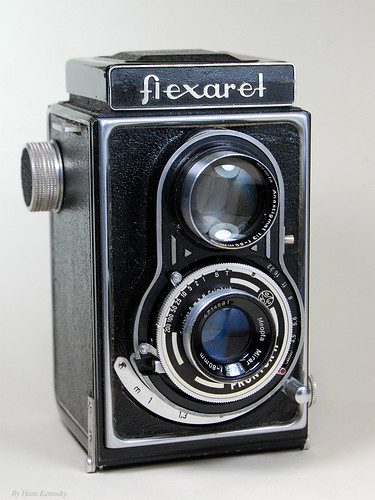Difference between revisions of "Flexaret II"
Hanskerensky (talk | contribs) (Added more information about variations) |
Hanskerensky (talk | contribs) m (typo) |
||
| Line 10: | Line 10: | ||
== Introduction == | == Introduction == | ||
| − | The Flexaret series of [[TLR]] cameras was made by [[Meopta]] (and its predecessors) in Czechoslovakia. The '''Flexaret II''' is a fully mechanical camera with an all-metal body. The body is covered in black leather. The viewing hood has a | + | The Flexaret series of [[TLR]] cameras was made by [[Meopta]] (and its predecessors) in Czechoslovakia. The '''Flexaret II''' is a fully mechanical camera with an all-metal body. The body is covered in black leather. The viewing hood has a magnifier and a sportsfinder. The name plate is marked ''flexaret'' only.<br> |
The Flexaret II shoots medium format 6x6 images on type 120 Rollfilm. | The Flexaret II shoots medium format 6x6 images on type 120 Rollfilm. | ||
Revision as of 10:52, 17 March 2013

|
| Meopta Flexaret II (late model) image by Hans Kerensky (Image rights) |
Introduction
The Flexaret series of TLR cameras was made by Meopta (and its predecessors) in Czechoslovakia. The Flexaret II is a fully mechanical camera with an all-metal body. The body is covered in black leather. The viewing hood has a magnifier and a sportsfinder. The name plate is marked flexaret only.
The Flexaret II shoots medium format 6x6 images on type 120 Rollfilm.
Transport and Shutter
The film is advanced by a knob on the right side. There's no automatic stop; the ruby window in the back has to be watched for the next frame number to appear. The Flexaret II has a Gauthier Prontor II leaf shutter (T, B, 1–1/200s) with selftimer but without flash synchronisation. A double exposure prevention is not present.
Lens and focus
The taking lens is a Meopta Mirar 80/4.5. The viewing lens is a Meopta Anastigmat 80/3.0. Focusing is done by a lever at the bottomside of the taking lens. The lens can be stopped down to f/22. The stopping down is stepless and controlled by a lever. Both lenses take 30mm push-on filters or hoods.
Variations
The following variations were observed : Early models (from 1946)carry none or still the Optikotechna Logo on the sportsfinder. Later models carry the Meopta Logo on the sportsfinder.
Links
Notes